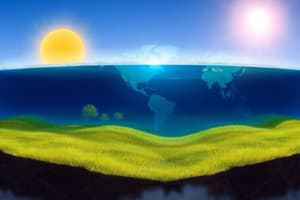Podcast
Questions and Answers
Which component of the Earth system absorbs thermal energy emitted by the sun and earth?
Which component of the Earth system absorbs thermal energy emitted by the sun and earth?
- Geosphere
- Biosphere
- Atmosphere (correct)
- Hydrosphere
What role do plants play in the carbon cycle within the biosphere?
What role do plants play in the carbon cycle within the biosphere?
- Acting as carbon sinks by absorbing carbon (correct)
- Reflecting sunlight to influence climate
- Transforming heat into thermal energy
- Releasing carbon dioxide into the atmosphere
How does the hydrosphere affect climate change?
How does the hydrosphere affect climate change?
- By absorbing solar energy exclusively
- By reflecting sunlight and holding heat (correct)
- By contributing to greenhouse gas emissions
- By facilitating soil erosion and weathering
Which gas primarily composes the atmosphere?
Which gas primarily composes the atmosphere?
What is a characteristic feature of ice and snow in the hydrosphere?
What is a characteristic feature of ice and snow in the hydrosphere?
What is the primary way to indirectly reduce water vapor in the atmosphere?
What is the primary way to indirectly reduce water vapor in the atmosphere?
Which of the following methods is effective in reducing carbon dioxide levels?
Which of the following methods is effective in reducing carbon dioxide levels?
What is the greenhouse gas with a global warming potential 25 times greater than carbon dioxide?
What is the greenhouse gas with a global warming potential 25 times greater than carbon dioxide?
Which activity significantly contributes to the increase of carbon dioxide in the atmosphere?
Which activity significantly contributes to the increase of carbon dioxide in the atmosphere?
What is a recommended method for reducing methane emissions from livestock?
What is a recommended method for reducing methane emissions from livestock?
What impact does the intensity of solar energy reaching Earth's surface have?
What impact does the intensity of solar energy reaching Earth's surface have?
Which statement best describes the greenhouse effect?
Which statement best describes the greenhouse effect?
How does the Earth's rotation influence energy flow in the climate system?
How does the Earth's rotation influence energy flow in the climate system?
What is the significance of albedo in Earth's climate system?
What is the significance of albedo in Earth's climate system?
Which factor does NOT significantly influence Earth's climate patterns?
Which factor does NOT significantly influence Earth's climate patterns?
What does high albedo indicate about a surface?
What does high albedo indicate about a surface?
How does a decrease in albedo affect the Earth’s surface temperature?
How does a decrease in albedo affect the Earth’s surface temperature?
What is the primary difference between climate and weather?
What is the primary difference between climate and weather?
How does the curvature of the Earth affect how sunlight reaches different regions?
How does the curvature of the Earth affect how sunlight reaches different regions?
Why does Toronto have a milder climate compared to Pierre, South Dakota?
Why does Toronto have a milder climate compared to Pierre, South Dakota?
What atmospheric condition is primarily measured when discussing weather?
What atmospheric condition is primarily measured when discussing weather?
Increased reflectivity (albedo) leads to which of the following outcomes?
Increased reflectivity (albedo) leads to which of the following outcomes?
What effect does a low albedo surface have on the environment?
What effect does a low albedo surface have on the environment?
What is one major effect of nitrous oxide on the environment?
What is one major effect of nitrous oxide on the environment?
What human activities are primarily responsible for the production of halocarbons?
What human activities are primarily responsible for the production of halocarbons?
How does ozone behave differently in the stratosphere compared to the troposphere?
How does ozone behave differently in the stratosphere compared to the troposphere?
What could be a potential solution to reduce the impact of methane emissions from rice paddies?
What could be a potential solution to reduce the impact of methane emissions from rice paddies?
Which of the following actions would help in reducing nitrous oxide emissions?
Which of the following actions would help in reducing nitrous oxide emissions?
What role does ozone play in the atmosphere at ground level?
What role does ozone play in the atmosphere at ground level?
What is a significant characteristic of halocarbons regarding their environmental impact?
What is a significant characteristic of halocarbons regarding their environmental impact?
Which practice can reduce halocarbons used in various industries?
Which practice can reduce halocarbons used in various industries?
What has been the most important indicator of global climate change in recent years?
What has been the most important indicator of global climate change in recent years?
How do thermal expansion and melting ice caps contribute to sea level rise?
How do thermal expansion and melting ice caps contribute to sea level rise?
What is a potential health risk associated with a warming climate?
What is a potential health risk associated with a warming climate?
During the period from January 1967 to January 1971, what relationship was observed between temperature, humidity, and skin disorders?
During the period from January 1967 to January 1971, what relationship was observed between temperature, humidity, and skin disorders?
How does an increase in average temperature lead to more precipitation?
How does an increase in average temperature lead to more precipitation?
Why is a changing climate considered a greater threat to forests than to agricultural crops?
Why is a changing climate considered a greater threat to forests than to agricultural crops?
What contributes to the spread of diseases carried by animals in a warming climate?
What contributes to the spread of diseases carried by animals in a warming climate?
What are the expected effects of rising temperatures on respiratory health?
What are the expected effects of rising temperatures on respiratory health?
Flashcards
Atmosphere
Atmosphere
The layer of gases surrounding Earth, primarily composed of nitrogen and oxygen. It absorbs heat from the sun and Earth, creating the greenhouse effect.
Hydrosphere
Hydrosphere
The collective sum of all Earth's water, including liquid water, ice, water vapor, and snow. It plays a key role in heat transfer and distribution.
Biosphere
Biosphere
The Earth's living organisms, including ecosystems, plants, animals, and microorganisms. It plays a critical role in the carbon cycle, absorbing and storing carbon.
Geosphere
Geosphere
Signup and view all the flashcards
Greenhouse Effect
Greenhouse Effect
Signup and view all the flashcards
Lithosphere
Lithosphere
Signup and view all the flashcards
Solar Energy
Solar Energy
Signup and view all the flashcards
Reflectivity (Albedo)
Reflectivity (Albedo)
Signup and view all the flashcards
Increase/Decrease in Albedo
Increase/Decrease in Albedo
Signup and view all the flashcards
Albedo (reflectivity)
Albedo (reflectivity)
Signup and view all the flashcards
High Albedo
High Albedo
Signup and view all the flashcards
Low Albedo
Low Albedo
Signup and view all the flashcards
Climate
Climate
Signup and view all the flashcards
Weather
Weather
Signup and view all the flashcards
Specific heat capacity
Specific heat capacity
Signup and view all the flashcards
Water's effect on climate
Water's effect on climate
Signup and view all the flashcards
Rock's effect on climate
Rock's effect on climate
Signup and view all the flashcards
Water vapor
Water vapor
Signup and view all the flashcards
Carbon dioxide
Carbon dioxide
Signup and view all the flashcards
Methane
Methane
Signup and view all the flashcards
Deforestation prevention and reforestation
Deforestation prevention and reforestation
Signup and view all the flashcards
Reduce livestock methane production and improve landfill management
Reduce livestock methane production and improve landfill management
Signup and view all the flashcards
Global Warming
Global Warming
Signup and view all the flashcards
How does global warming affect sea levels?
How does global warming affect sea levels?
Signup and view all the flashcards
How does climate change affect human health?
How does climate change affect human health?
Signup and view all the flashcards
Summarize the relationship between temperature, humidity, and skin diseases.
Summarize the relationship between temperature, humidity, and skin diseases.
Signup and view all the flashcards
How does increased temperature lead to more precipitation?
How does increased temperature lead to more precipitation?
Signup and view all the flashcards
Why is climate change a bigger risk to forests than crops?
Why is climate change a bigger risk to forests than crops?
Signup and view all the flashcards
What is climate change?
What is climate change?
Signup and view all the flashcards
What is the greenhouse effect?
What is the greenhouse effect?
Signup and view all the flashcards
Nitrous Oxide
Nitrous Oxide
Signup and view all the flashcards
Halocarbons
Halocarbons
Signup and view all the flashcards
Ozone Layer
Ozone Layer
Signup and view all the flashcards
Ozone
Ozone
Signup and view all the flashcards
Mitigation
Mitigation
Signup and view all the flashcards
Study Notes
Earth's Climate System Components
- Atmosphere: Surrounds Earth, absorbs energy from the sun and Earth, primarily composed of nitrogen (N2) and oxygen (O2), with water vapor (H2O) and other gases. The greenhouse effect traps heat.
- Hydrosphere: All the water on Earth (liquid, ice, vapor, snow). It transfers heat around the globe.
- Biosphere: All living organisms and their ecosystems on Earth. Plants play a crucial role in the carbon cycle, absorbing carbon. Forests, grasslands, and other ecosystems act as carbon sinks.
- Geosphere (Lithosphere): The solid, rocky outer layer of Earth, with tectonic plates and various landforms.
Solar Energy
- The sun provides energy for Earth's climate system.
- Solar energy intensity affects temperatures.
- The sun's output fluctuates, affecting climate patterns.
- Earth's orbit and rotation influence seasonal changes.
Greenhouse Effect
- Solar energy enters the atmosphere and is absorbed by the surface.
- Earth radiates heat back into the atmosphere.
- Greenhouse gases absorb this heat and re-emit it in all directions.
- This creates a warming effect, maintaining a livable temperature range.
Reflectivity (Albedo)
- Albedo is the amount of solar energy reflected back into space by surfaces like snow, ice, land, and oceans.
- High albedo surfaces are light-colored, reflecting more energy and causing cooling.
- Low albedo surfaces are dark-colored, absorbing more energy and causing warming.
Climate vs. Weather
- Climate: Long-term average weather patterns in a region.
- Weather: Short-term atmospheric conditions at a specific time and place.
Earth's Energy and Climate
- Earth's movement and shape influence how sunlight hits the planet.
- Different angles of sunlight lead to variations in temperature (e.g., poles vs. equator).
- The curvature of the Earth affects the amount of sunlight hitting different latitudes.
Specific Heat Capacity (Water vs. Rock)
- Water has a high specific heat capacity. This means it requires a lot of energy to change temperature, moderating temperature fluctuations in areas near large bodies of water.
- Rock has a lower specific heat capacity, leading to more rapid temperature changes.
Mountain Ranges and Climate
- Mountains affect precipitation patterns.
- Moist air rises over mountains, cools, and releases precipitation.
- Dry air descends on the leeward side, resulting in arid conditions.
Mount Pinatubo Eruption and Temperature
- The 1991 eruption released gases into the atmosphere.
- These gases reflected some incoming solar radiation, leading to temporary cooling for several years.
Factors Affecting Earth's Climate
- Solar energy, greenhouse effect, reflectivity (albedo), and Earth's movement and shape (inclination, revolution, etc).
- Atmosphere, Hydrosphere, Geosphere (Lithosphere), and Biosphere
Indicators of Global Warming
- Changes in glacial and polar ice
- Rising sea levels
- Ocean Acidity
Studying That Suits You
Use AI to generate personalized quizzes and flashcards to suit your learning preferences.



